Greetings, Conscientious Food Consumers!
The sunshine season has finally arrived here in the Mid-Willamette Valley, and with it the bursting cornucopias of fresh colorful fruits and veggies in our local gardens and Farmers’ Markets — from strawberries, beans and broccoli to cherries, peaches and snap peas. Hooray for our local growers and harvesters!
One “fruit” I particularly enjoy that is not grown locally is avocado — also known as the “alligator pear” because of its shape and mottled, reptilian-like skin. Botanically speaking, it is a fruit (actually a berry)! It’s also a nutritional superstar, containing healthy fats, fiber, potassium and an impressive profile of other vitamins that make it a staple of healthy and specialized diets like keto.

Many of the avocados consumed in the U.S. are grown in California, so they are plentiful in Oregon. I love ’em stuffed and on toast, in guacamole, sushi, fresh salads, dressing, salsa and many other dishes. Avocado is also a prime ingredient in high quality cooking oil, skin care and cosmetic products.
But as I have experienced — and I bet you have too — avocados are highly perishable! How often do you need more than one and bring home a discounted mesh bag of avocados, intending to make a big dish of guacamole (we love this recipe from First Alternative Co-op)… only to find yourself stuck with a batch of mushy, shriveled or off-tasting avos several days later?
For sure it happens, and I CONFESS: I’m still working on “no alligator pears left behind”! I tend to waste 1-2 a month, for varying reasons (more on that below).
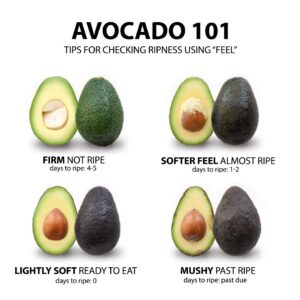
HOW TO RIPEN & STORE YOUR “ALLIGATOR PEARS”
The first thing to remember about avocados after you get them home is that they emit ethylene, a naturally-occurring gas given off by certain fruits (such as bananas, apples and tomatoes) as part of their maturation cycle.
This off-gassing will speed up the ripening (and potential waste) of nearby fruit or veggies. If you want to help those rock-hard avocados along in that process, place them in a paper bag (not plastic), labeled, with the date.
- Check these tips from the experts in the avocado industry. (They do NOT recommend consuming the pits!)
- As advised in our handy A-Z Fruit and Vegetable Storage Guide, store them separately from other fruits or veggies on the counter and check often for ripeness, before transferring to a visible/accessible spot in the fridge (your “Eat First” area). (Keep separate.)
- One of our regular Kitchen Confessions readers has discovered the egg rack in the refrigerator door is perfect for storing avocados!
- To prevent browning on cut avocados, spritz on some lemon or lime juice and store in an airtight container or wrapped in plastic.
- Check Still Tasty.com for more details about storing fresh avocados.
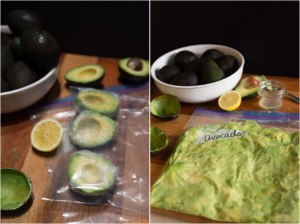
WHAT TO DO WITH THOSE OVER-RIPE “ALLIGATOR PEARS”
- PUREE ‘EM and stick ’em in puddings or smoothies! BigOven.com has lots of recipes for Chocolate Avocado mousse.
- BAKE WITH ‘EM: Make avocado chocolate chip brownies or muffins! Check your favorite foodie website or blog.
- FREEZE ‘EM (after slicing or pureeing) and transfer to freezer-safe containers for later use (don’t forget to make a note on your handy Freezer Inventory!)
- DON’T MAKE GUAC WITH ‘EM! In my experience, bad avos ruin the taste.
- GROW AN AVOCADO HOUSEPLANT with the pit.
*****
Now for this edition’s Kitchen Confessions!
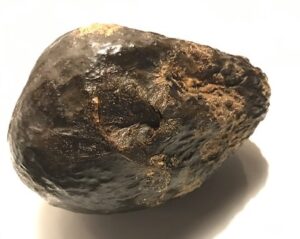
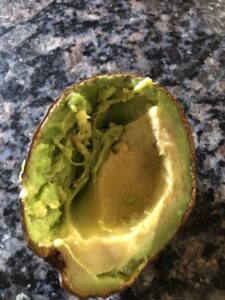
KAREN CONFESSES:
I love avocados, but can never eat a whole one at one time. Even when I buy just one at a time and try to carefully monitor its ripening, I frequently end up with the other half becoming inedible!
At left, an avo that was at the appropriate stage of ripeness. But during a recent roadtrip, it had spent some time in and out of the cooler, and had begun to spoil. After a couple of off-tasting spoonfuls, I made a shake with the rest.
At right, a dead avo that I put in a paper bag on the counter to ripen, then forgot that it was in there! (It was an unlabeled, nondescript paper bag that I managed to ignore.)
$$$ WASTED: Around $5-$6/month
LESSONS LEARNED: Mark the bag or put an “Eat First” label on my brown bagged avocados. Also I will probably start buying two avocados at a time, use one right away, and follow my own advice to puree/freeze one avocado for later!
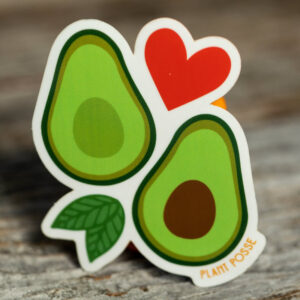
NO FOOD LEFT BEHIND IN THE MEDIA
Did you see our spread in the Summer 2021 issue of the Co-op Thymes? Many thanks to Editor Adam Payson for this wonderful feature!



 Carrot Top Pesto & other “zero waste” ideas
Carrot Top Pesto & other “zero waste” ideas
This is a test. Trying to leave a comment.
We see your test comment!